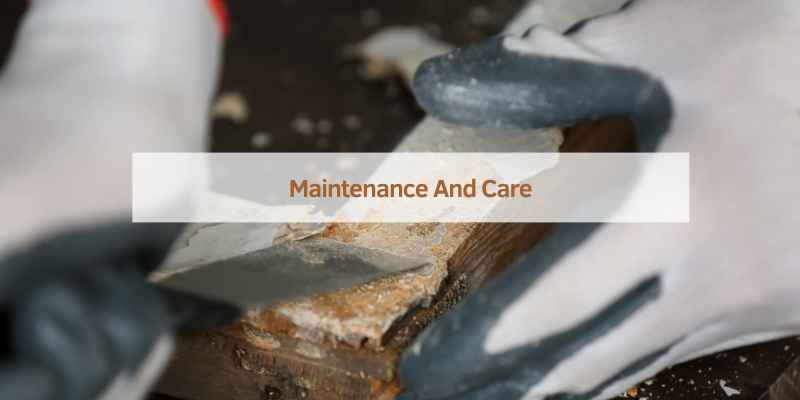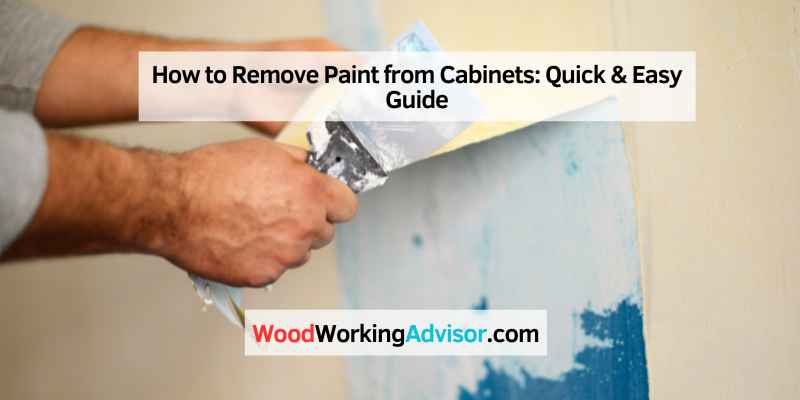To remove paint from cabinets, use a paint stripper and a scraper to gently peel off the paint layers. You can also opt for sanding or heat guns for stubborn paint.
Revamping your cabinets by removing old paint can give your kitchen a fresh and updated look. Whether you’re aiming for a rustic, modern, or traditional style, having paint-free cabinets is a crucial step in achieving your desired aesthetic. While the process may seem daunting at first, with the right tools and techniques, you can easily strip off the old paint and reveal the natural beauty of your cabinets underneath.
In this blog post, we will explore various methods and tips on how to effectively remove paint from cabinets, helping you transform your space and breathe new life into your kitchen.
Introduction To Paint Removal From Cabinets
Removing paint from cabinets is a common and necessary task for anyone looking to refresh the appearance of their kitchen or bathroom. Over time, paint can become chipped, discolored, or simply outdated, leading homeowners to seek out ways to restore the natural beauty of their cabinetry. Whether you’re planning to repaint the cabinets or restore them to their original state, knowing how to remove paint from cabinets is a valuable skill. In this guide, we’ll explore the importance of paint removal and the essential tools and materials needed for the job.
Why Removing Paint Matters
Paint removal is crucial for achieving a smooth and professional finish when refinishing cabinets. By eliminating old paint layers, you ensure that the new paint or stain adheres properly, resulting in a durable and visually appealing surface. Furthermore, removing old paint allows you to inspect the condition of the cabinets, identify any imperfections, and address them before applying a new finish. This process is essential for achieving a high-quality, long-lasting result.
Tools And Materials Needed
To effectively remove paint from cabinets, you will need a set of essential tools and materials. These include chemical paint strippers, scraper or putty knife, sandpaper, protective gloves, and safety goggles. Additionally, you may require denatured alcohol, old rags, and a well-ventilated workspace. Proper preparation and the right equipment are crucial for ensuring a successful paint removal process without causing damage to the cabinets.

Safety First: Preparing Your Workspace
When it comes to removing paint from cabinets, ensuring safety is the first and foremost priority. Preparing your workspace with the necessary precautions is essential to avoid any potential hazards. In this section, we will cover the important safety measures to consider before starting the paint removal process.
Ventilation And Protective Gear
Proper ventilation is crucial when working with paint removal chemicals or sanding cabinets. Ensure that the workspace is well-ventilated by opening windows and using fans to promote air circulation. Additionally, wearing protective gear such as goggles, gloves, and a mask is imperative to safeguard yourself from harmful fumes and particles.
Securing The Area
Before initiating the paint removal process, it’s essential to secure the surrounding area. Cover the floor and nearby furniture with drop cloths or plastic sheets to prevent any accidental spills or splatters. Clear the workspace of any unnecessary items to create a safe and unobstructed environment for the paint removal task.
Choosing The Right Method
When it comes to removing paint from cabinets, there are several methods you can choose from. The key is to choose the right method for your specific situation to ensure that you achieve the best results. Here are some of the most effective methods you can use:
Chemical Strippers
One of the most popular methods for removing paint from cabinets is by using chemical strippers. These products work by breaking down the chemical bonds in the paint, making it easier to remove. To use a chemical stripper, you need to apply it to the painted surface and wait for it to soften the paint. Once the paint has softened, you can use a scraper to remove it from the cabinet surface.
Sanding
Sanding is another effective method for removing paint from cabinets. This method involves using sandpaper or a sanding machine to sand away the paint from the cabinet surface. Sanding is a good option if you want to remove paint from intricate or hard-to-reach areas. However, sanding can be time-consuming and messy, so it’s important to take precautions to protect yourself and your workspace.
Heat Guns
Heat guns are a powerful tool for removing paint from cabinets. These devices work by heating the paint, causing it to bubble and peel away from the cabinet surface. To use a heat gun, you need to apply heat to the painted surface and then use a scraper to remove the paint. Heat guns are effective for removing multiple layers of paint, but they can be dangerous if not used properly. It’s important to wear protective gear and follow safety guidelines when using a heat gun.
Choosing the right method for removing paint from cabinets depends on several factors, including the type of paint, the age of the cabinets, and the condition of the cabinet surface. By considering these factors and using the appropriate method, you can achieve a smooth and clean surface that’s ready for painting or refinishing.
Step-by-step Guide: Using Chemical Strippers
When removing paint from cabinets, using chemical strippers can be an effective method. Follow these steps for a successful paint removal process.
Application Tips
- Apply chemical stripper evenly with a brush.
- Allow stripper to sit according to manufacturer’s instructions.
- Scrape off softened paint with a putty knife.
- Repeat application for stubborn paint layers.
Removing Residue
- Wipe cabinets with a damp cloth to remove residue.
- Use steel wool to scrub remaining paint spots.
- Sand cabinets lightly for a smooth surface.
Cleanup And Disposal
Dispose of paint residue and used strippers according to local regulations. Ensure proper ventilation during cleanup.
Step-by-step Guide: Sanding
When it comes to removing paint from cabinets, sanding is an essential step that helps create a smooth and clean surface. In this step-by-step guide, we will walk you through the process of sanding your cabinets effectively.
Choosing Sandpaper
Before you start sanding, it’s crucial to choose the right sandpaper for the job. The type of sandpaper you select will depend on the condition of your cabinets and the level of paint you need to remove. Here are some options:
| Type | Coarseness | Best For |
|---|---|---|
| Coarse | 40 to 60 grit | Heavy paint buildup |
| Medium | 80 to 120 grit | Medium paint buildup |
| Fine | 150 to 180 grit | Light paint buildup |
It’s important to note that different types of wood may require different sandpaper grits. Experiment with a small area before proceeding to ensure you achieve the desired results.
Sanding Techniques
Now that you have the right sandpaper, it’s time to start sanding your cabinets. Follow these techniques to ensure an effective and efficient sanding process:
- Start by sanding in the direction of the wood grain. This helps prevent scratches and ensures a smoother finish.
- Apply even pressure while sanding, but avoid pressing too hard, as it can damage the wood surface.
- Use long, smooth strokes to cover the entire surface area. Avoid sanding in a back-and-forth motion, as it can leave visible marks.
- Periodically check the sandpaper for clogging. If it becomes clogged with paint residue, gently tap it against a hard surface to remove the buildup.
- Continue sanding until the paint is completely removed, and the cabinets have a smooth and even finish.
Dust Management
During the sanding process, it’s essential to manage dust to maintain a clean and healthy working environment. Here are some tips for effective dust management:
- Wear a dust mask to protect yourself from inhaling dust particles.
- Use a shop vacuum or a dust collection system to capture the dust as you sand.
- Regularly clean the work area to minimize the spread of dust.
- Consider setting up a temporary plastic barrier to contain the dust within the workspace.
By following these steps, you can successfully remove paint from your cabinets through sanding. Remember to take your time, work carefully, and prioritize safety throughout the process. Once you have completed the sanding step, you will be one step closer to achieving beautifully refinished cabinets.
Step-by-step Guide: Heat Guns
Discover the effective method of using heat guns to remove paint from cabinets. Follow this step-by-step guide for successful paint removal and restoration. Master the process and achieve professional results with ease.
Setting Up
Prepare work area. Place drop cloth.
Put on safety goggles and gloves.
Application Tips
Hold heat gun 6-8 inches away.
- Move gun constantly to avoid scorching.
- Work in small sections for best results.
Safety Measures
- Ensure proper ventilation in room.
- Keep heat gun away from water sources.
- Avoid pointing gun at yourself or others.
Finishing Touches
To remove paint from cabinets, follow these simple steps for a flawless finish. First, gather your supplies including a paint scraper, sandpaper, and a chemical paint remover. Next, carefully scrape off the old paint, then sand the surface to remove any remaining residue.
Finally, apply the paint remover and wipe away the paint, revealing beautifully refreshed cabinets.
Smoothing Surfaces
To achieve a smooth surface after removing paint from cabinets, you need to sand the surfaces. Start with a coarse grit sandpaper, like 60 grit, and sand the surface in a circular motion. Then, switch to a finer grit, like 120 grit, and sand the surface again. Repeat the process with even finer grits until you achieve the desired smoothness.
Applying Primer And Paint
After smoothing the surfaces, it’s time to apply primer and paint to your cabinets. First, apply a coat of primer to ensure the paint adheres to the surface and covers any remaining spots. Allow the primer to dry completely before applying the paint.
When applying paint, use a brush or roller to apply it in thin, even coats. Avoid using too much paint at once to prevent drips and unevenness. Allow each coat to dry completely before applying another coat, and repeat until you achieve the desired coverage.
Additional Tips
– When sanding, wear a mask to avoid inhaling dust particles.
– Use a high-quality primer and paint for best results.
– Consider using a paint sprayer for a smoother finish.
– Allow the cabinets to dry completely before reattaching hardware and using them.
By following these steps, you can remove paint from your cabinets and give them a fresh new look. Remember to take your time and be patient throughout the process for the best results.
Maintenance And Care
Maintenance and care are essential when it comes to keeping your cabinets looking pristine. Proper cleaning and touch-up techniques can help prevent the need for paint removal altogether. Here are some tips to keep your cabinets looking their best.
Routine Cleaning
Regular cleaning is crucial to prevent dirt and grime buildup on your cabinets. Wipe down your cabinets with a soft cloth and warm, soapy water at least once a week. Avoid using abrasive cleaners or scrubbers, as they can damage the finish of your cabinets.
Touch-up Tips
Small nicks and scratches can be easily touched up to prevent the need for full paint removal. Use a touch-up kit or paint that matches the color of your cabinets to cover up any imperfections. Be sure to follow the manufacturer’s instructions and allow the touch-up paint to dry completely before using your cabinets again.
Summary
Maintaining and caring for your cabinets can help prevent the need for paint removal. Regular cleaning and touch-up techniques can keep your cabinets looking new for years to come.

Frequently Asked Questions
How Do I Remove Paint From Cabinets Without Damaging The Surface?
To remove paint from cabinets without damaging the surface, start by gently scraping off any loose paint using a plastic scraper. Then, apply a paint stripper or a mixture of vinegar and water to soften the remaining paint. Finally, use a clean cloth or sponge to wipe away the softened paint, rinsing frequently.
What Are Some Eco-friendly Methods For Removing Paint From Cabinets?
There are several eco-friendly methods for removing paint from cabinets. One option is to use a soy-based paint stripper, which is non-toxic and biodegradable. Another option is to try heat-based methods, such as using a heat gun or a hot water soak, to soften the paint for easy removal.
Can I Use Sandpaper To Remove Paint From Cabinets?
Yes, sandpaper can be used to remove paint from cabinets. Start by using a coarse-grit sandpaper to remove the majority of the paint, then switch to a finer grit to smooth out the surface. However, be cautious not to sand too aggressively, as it can damage the cabinet’s finish.
Always sand in the direction of the wood grain for the best results.
Conclusion
Removing paint from cabinets is a manageable task with the right tools and techniques. Taking the time to prepare and choosing the appropriate method can lead to successful results. Whether using chemical strippers or sanding, following safety precautions is essential.
With patience and attention to detail, you can achieve beautifully restored cabinets.

